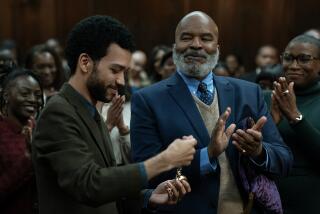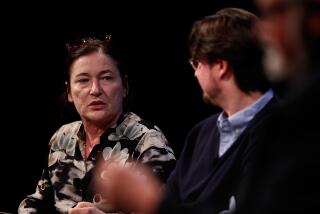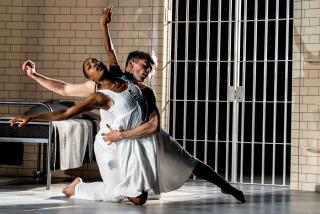The Siren’s Call: Step right up!
The novel “The Night Circus” (Doubleday: 387 pp., $26.95) is receiving a good deal of attention, and it’s rightly deserved — even though some comparisons of Erin Morgenstern’s fable to other popular books seem sky-high and unfair (to her). Does anyone’s book, for instance, really deserve the pressure of being called the next Harry Potter? Can anyone live up to that?
In the vaguest of terms, there’s a similarity to Rowling’s saga. Morgenstern’s novel also centers on two dueling magicians, one of whom is difficult to pin down by name. The pawns in their odd, extended game are several sweet, young innocents who struggle to uncover their own destinies just like Harry and his friends. And the drama takes place among an interesting assortment of characters populating the Cirque des Rêves, which does seem, a little, like Hogwarts.
But let’s stop there since Morgenstern takes those familiar elements and makes them wholly her own.
Prospero the Enchanter and the man known as A.H. (and occasionally as Alexander) are both old men, but their antagonism seems much older — timeless, even. Their battleground is a circus that opens only at dusk: It’s a magical, monochrome affair, painted in chessboard black and white. The pair, however, don’t challenge each other directly but via proxies. Each takes and trains an apprentice from childhood in the ways of magic.
Morgenstern keeps everything — the two men, the nature of their game — obscure, like a sleight-of-hand artist. But there’s an ominous hint of what’s to come for both apprentices — Prospero’s is Celia, his own daughter; A.H.’s is a youth named Marco — in an early scene in which Prospero takes a knife and slits his little daughter’s fingertips. She cries out, and he watches as “the skin melds together…closing solidly once more. Her father gives her only moments to rest before slicing each of her newly healed fingers again.”
Why test her ability to reheal herself if it won’t be important later?
The early part of the book follows the planning and creation of the Cirque des Rêves, revealing how each performer and each act is thoughtfully, carefully added to the ensemble. The circus travels far and wide without any effort (and, seemingly, without the need of a train) so that many are astounded, as is one devout, tragic attendee, who cannot believe “the field it sits in now, as though it has always been there, had been empty the day before…”
The two old men hover behind the scenes, while the circus’ apparent proprietor is Chandresh Lefèvre, an accomplished showman and nearly transcendent knife-thrower. Marco becomes his assistant. Soon, into their midst arrives a young illusionist, Celia, whose incredible skills include turning inanimate things into flapping birds that fly around before resuming their original forms. Each young person has no idea about his/her opponent. Instead, they use their intuition to discover each other’s identity as well as the true nature of the game. At one point Marco describes his understanding of it to Isobel, a beautiful fortuneteller who wishes the card for the lovers in her Marseilles tarot deck applied to them:
“ ‘It’s a set of scales: one side is mine, the other is hers.’
“A set of scales appears on the table between the cards, balancing precariously, each side piled with diamonds that sparkle in the candlelight.
“ ‘So the object is to tip the scales in your favor?’ Isobel asks.
“Marco nods…”
Thus that early glimpse of the circus black and whites and its suggestion of a chessboard motif are all wrong. The game turns upon a notion of balance and harmony, which both old men want to upset and which the young people (not just Celia and Marco, but several others as well), as they grow into adults, wish to maintain. At first, though, Marco and Celia each use the circus as a painter would a canvas to show off their magical cleverness and tip the proverbial balance in each’s favor.
If this is all a bit obscure, it’s supposed to be: “The Night Circus” is a very atmospheric tale in which things are seen in the half-light of another century’s lamps. Morgenstern makes much of these shadows. She also clearly savors objects such as unusual clocks, vanishing rings, flaming cauldrons and strange carousels, and will make you savor them as well. (Want to take a ride on a griffin or a wyvern?) I imagine she’d ditch a GPS in her car and use an old, brass compass instead.
In this theatrical setting, her characters struggle against what’s been predetermined to create their own lives and fates, or attempt to stop the game with a knife “spinning in perfect revolutions through the air” or choose whom they want to love (which complicates not just the game but the lives of everyone involved).
There’s also quite a bit of narrative breathiness. Be forewarned: Morgenstern tends to overdramatize everything and everyone so that no gesture or object, not even a rain-soaked gown, simply dries: Instead, we’re told to notice “the almost-black color returning to a rich wine.” There’s also plenty of improbability to the encounters and circumstances that have led some early reviewers to call the plotting “creaky.” But, listen, this is a story about magic, and it involves a circus. Where else does improbability reign as the norm, not the exception?
*
So freighted with meaning and mystery, that word, circus—from kirkos, the Greek for “circle.” Let’s associate for a moment.
A circle: Like the shape of spectacles worn by a circus goer.
A circus: A space that contains a spectacle
A circle: A space consecrated by magicians with, usually, a blade of virginal steel and where psychical energies are focused, where different planes of reality meet.
A circle: A symbol for eternity, for timelessness.
Is it any wonder, then, that, cotton candy and clowns aside, a circus evokes so much mystery for the mythically inclined?
*
This strange mythic quality is embodied by another novel that quietly appeared — reappeared, actually — in the middle of the summer, Charles G. Finney’s short novel “The Circus of Dr. Lao” (Bison Books: 154 pp., $14.95 paper).
Finney was an Arizona newspaperman, and “The Circus of Dr. Lao” was his first novel, published in 1935. Calling this book, with its larger-than-usual typeface and layout, a novel seems a bit of a stretch. But as you begin reading it, you find dimension and depth captured with great economy, influenced, no doubt, by Finney’s being a journalist accustomed to fitting big ideas into small spaces.
The publisher says the book was influential for Ray Bradbury (and was also later adapted into a 1964 movie), who wrote his own far darker circus story in “Something Wicked This Way Comes”— a graphic novel adaptation by Ron Wimberly appeared this summer (Hill and Wang: 133 pp., $30/$15.95 paper).
Bradbury’s and Finney’s stories couldn’t be more different. Take their openings. The arrival of Bradbury’s carnival is full of foreboding (a wind is stirring, storm clouds loom). Finney’s is pitiful, pathetic. Though a grand, mysterious advertisement appears in the local newspaper in Abalone, Ariz., what comes down the dusty streets hardly seems to measure up. Or does it? A faltering figure, described as a “little old Chinaman,” leads a pathetic, rickety procession of three wagons.
And yet. And yet.
The townspeople’s tongues are set to wagging — more than they’ve probably done in a long time —over what they see. Correction: what they think they see. Is that a bear in one of the wagons? Or is it a man? Or a Russian? What about the wagon driver: is he just some poor old fellow dressed in a costume with goat horns on his head or is he a “real honest-to-god satyr driving a gold-plated mule down the main drag of a hick town?” (Note: “gold-plated mule”—see Apuleius, “The Golden Ass.”)
In spite of their skepticism, in spite of their unwillingness to embrace the mystery of this circus, the townspeople are swept away. Rather than focus on one particular character, Finney follows different townspeople, recording their experiences with Dr. Lao’s circus.
Lonely Agnes Birdsong is nearly seduced by the wagon-driving satyr; the Rogers family and two policemen enter a tent to view a real Medusa (well, her reflection), which leads to this aside by the good doctor: “It is very distressing for us always to have one or two customers turned to stone at every performance, besides being very difficult to explain to the police.” A man who’s been chipped away by illness and accidents — he wears prosthetic devices, false teeth, has metal plates in his head — finds unexpected sympathy in the chimera, a beast whose body also consists of mis-matched parts.
And then there’s the hilarious experience of widowed Mrs. Howard T. Cassan. She hears nothing encouraging from the fortuneteller, Apollonius of Tyana. He doles out a fierce, bleak picture of her future that the stubborn lady refuses to accept. When he tells her to imagine “an old cornstalk turning brown, drying, but refusing to fall over…. That is you,” her reaction is: “Well, I must say, you are the strangest fortuneteller I ever visited.”
She loves his candor so much, in fact, that she’s attracted to him, causing Apollonius to tell her: “Madam, I am nearly two thousand years old, and all that time I have been a bachelor. It is too late to start over again.” The widow Mrs. Howard T. Cassan, however, won’t take “no” for an answer.
Finney’s “The Circus of Dr. Lao” is a glorious little book about the way that classical myths can gild our bland, tedious lives. We never really learn why this circus stops in Abalone rather than New York City or Chicago. My guess is that Finney wanted to show how myth, “that weird netherworld of unbiological beings,” can arrive in even the most forgotten corners. You don’t need to be near the centers of things to have interesting experiences, and that should give hope to most of us.
The Siren’s Call appears monthly at latimes.com/books
More to Read
Sign up for our Book Club newsletter
Get the latest news, events and more from the Los Angeles Times Book Club, and help us get L.A. reading and talking.
You may occasionally receive promotional content from the Los Angeles Times.






